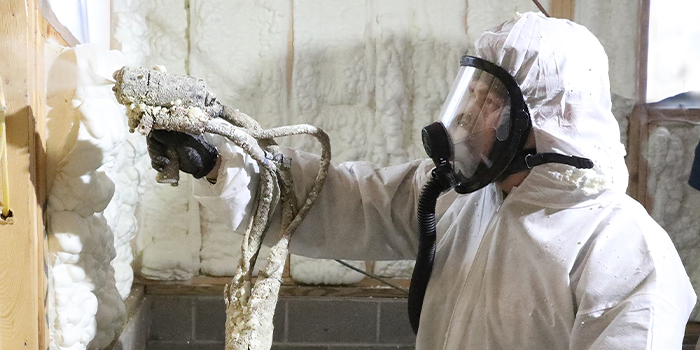Building Breathable Safety


SPRAY FOAM MAGAZINE – Health and safety must be a priority in the spray foam applicators workplace. As with many aspects of the construction industry, there are risks and hazards on building sites, so risk assessments and safety precautions are vital to help keep workers safe. Companies should view health and safety at the core of their training and processes, with spray foam contractors having training and safe work practices put into action to prevent exposure before, during, and after an installation.
There is no doubt that construction is one of the most dangerous jobs in the world with potential dangers from working at heights, operating dangerous machinery, and working with potentially hazardous substances and materials. Therefore, having manufacturers who specialize in safety equipment and are known for their quality, in addition to their understanding of the spray foam industry, is a good place to start when kitting out a spray foam crew. Giving piece of mind to all workers and employers as well as following Occupational Safety and Health Administration (OSHA) strict safety standards. Bullard is considered one such manufacturer.
Believing in advancing human safety so people can live long productive lives, Bullard produces quality personal protective equipment (PPE) that does the job properly. A fifth-generation family-owned business, they have a variety of durable products that can help protect spray foam applicators. From their supplied air systems, purifying respirators, or supplied air respirators to their well-known hard hat design.
In recent years, research has shown that inhaling isocyanate vapors and aerosols during SPF insulation will typically exceed OSHA’s permissible exposure limits (PELs), and hence skin, eye, and respiratory protection is needed. According to the Environmental Protection Agency (EPA), cutting or trimming the foam as it hardens (tack-free phase) may generate dust that may contain unreacted isocyanates and other chemicals. Exposure to isocyanates can cause severe allergic reactions, including asthma attacks. This and other reactions can continue throughout the application until the product is remedied. These fumes can also cause painful headaches and other health effects. Workers utilizing full-face masks with changeable filters, may not be getting the full protection or longevity needed.
In the summer, heat stress for spray foam applicators is a concern, with many installers working in confined spaces with high temperatures. Improper PPE ensemble can result in dangerous heat stress, which can in turn result in a major health concern and less productivity due to needing frequent breaks to reduce stress on the body. Having a product that can help contractors stay 30 degrees cooler than the ambient temperature will help reduce heat stress. In addition, having the option to adjust the airflow control valves will allow contractors to modify the incoming air temperature to a level that works for individuals.
Even though OSHA requires the use of respiratory protection when using SPF, not all spray foam contractors use a system that circulates clean air and cools the worker down. However, experience on the job soon makes a contractor realize the benefits of such a system. From making it easier for the worker to breathe, blocking isocyanates, protecting them against heatstroke, and increasing productivity along with long-term financial savings.
Not only must spray foam companies stay compliant with up-to-date safety standards, but they must always remember to put their contractor’s health first. Dealing with a reliable and quality personal protective equipment (PPE) manufacturer will give the spray foam employee piece of mind and help keep workers safe.
*Spray Foam Magazine does not take editorial positions on particular issues; individual contributions to the magazine express the opinions of discrete authors unless explicitly labeled or otherwise stated. The inclusion of a particular piece in the magazine does not mean that individual staff members or editors concur with the editorial positions represented therein.
For use by SprayFoamMagazine.com & Spray Foam Magazine
Disqus website name not provided.










































